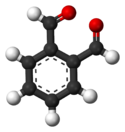- Phthalaldehyde
-
Phthalaldehyde 
 o-PhthalaldehydeOther nameso-Phthalic dicarboxaldehyde
o-PhthalaldehydeOther nameso-Phthalic dicarboxaldehyde
Benzene-1,2-dicarboxaldehyde
PhthaldialdehydeIdentifiers CAS number 643-79-8 
PubChem 4807 ChemSpider 4642 
RTECS number TH6950000 Jmol-3D images Image 1 - O=Cc1ccccc1C=O
- InChI=InChI=1S/C8H6O2/c9-5-7-3-1-2-4-8(7)6-10/h1-6H
Properties Molecular formula C8H6O2 Molar mass 134.13 g mol−1 Appearance Yellow solid Melting point 114-116 °C
Boiling point 266.1 °C
Solubility in organic solvents Soluble Hazards R-phrases R36/37/38 S-phrases S26 S28 S36 Flash point 98.5 °C  (verify) (what is:
(verify) (what is:  /
/ ?)
?)
Except where noted otherwise, data are given for materials in their standard state (at 25 °C, 100 kPa)Infobox references o-Phthalaldehyde or ortho-phthalaldehyde is the chemical compound with the formula C6H4(CHO)2. Often abbreviated OPA, the molecule is a dialdehyde, consisting of two formyl (CHO) groups attached to adjacent carbon centres on a benzene ring. This pale yellow solid is a building block in the synthesis of heterocyclic compounds and a reagent in the analysis of amino acids.
Contents
Synthesis
The molecule was first described in 1887 when it was prepared from α,α,α',α’-tetrachloro-ortho-xylene.[1] A more modern synthesis is similar: the hydrolysis of the related tetrabromoxylene using potassium oxalate, followed by purification by steam distillation.[2] The reactivity of OPA is complicated by the fact that with water it forms both a mono- and dihydrate, C6H4(CHO)(CH2OH) and C6H4(CH2OH)2, respectively.[3]
Isomeric phthalaldehydes
Related to o-phthalaldehyde are the meta and para isomers, which are respectively named isophthalaldehyde (m.p. 87-88 °C, CAS# 626-19-7) and terephthalaldehyde (m.p. 114-116 °C, CAS# 623-27-8).
Biochemistry
Ortho-phthalaldehyde (OPA) is well soluble, and stable in water solution at pH<11.5. It is however sensitive to UV illumination and air oxidation.
OPA is used as a very sensitive fluorescent reagent for assaying amines or sulfhydryls in solution, notably contained in proteins, peptides, and aminoacids, by capillary electrophoresis and chromatography. OPA reacts specifically with primary amines above their isoelectric point Pi in presence of thiols. OPA reacts also with thiols in presence of an amine such as n-propylamine or 2-aminoethanol. The method is spectrometric (optical absorbance at 436-475nm (max 455nm) with excitation at 330-390nm (max.340nm)) [4].
Disinfection
Ortho-phthalaldehyde is commonly used as a high-level disinfectant for medical instruments. Disinfection with OPA is indicated for semi-critical instruments that come into contact with mucous membranes or broken skin, such as specula, laryngeal mirrors, and internal ultrasound probes.[5]
Poly(phthalaldehyde)
Phthalaldehyde can be polymerized. In the polymer, one of the oxygen atoms forms a bridge to the other non-ring carbon of the same phthalaldehyde unit, while the other bridges to a non-ring carbon of another phthalaldehyde unit. Poly(phthalaldehyde) is used in making a photoresist.[1]
References
- ^ Colson, A.; Gautier, H. "Nouveau Mode de Chloruration des Carbures" Annales de Chimie (Paris), 1887, volume 6, number 11, pp. 28.
- ^ Bill J. C.; Tarbell, D. S. “o-Phthalaldehyde” Organic Syntheses, Collected Volume 4, p.807 (1963). http://www.orgsyn.org/orgsyn/pdfs/CV4P0807.pdf
- ^ Zuman, H. "Reactions of Orthophthalaldehyde with Nucleophiles" Chemical Reviews 2004; volume 104, pp. 3217-3238. doi:10.1021/cr0304424
- ^ Protocol by Uptima
- ^ College of Physicians and Surgeons of Ontario. "Infection Control in the Physician's Office". 2004 edition. http://www.cpso.on.ca/Publications/infectioncontrolv2.pdf
External links
Categories:- Aldehydes
- Aromatic compounds
Wikimedia Foundation. 2010.
